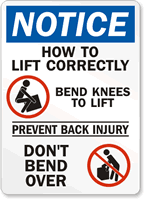
Construction workers and laborers are the backbone of society and need to stay in tip-top shape for the work that they do. However, the potential for injury in the workplace is all too great. The Bureau of Labor Statistics (BLS) shows that more than
one million workers suffer back injuries each year, with
75% occurring when the employees were lifting. An injured back is a serious injury that leaves people down for the count, so workers and employees need to educate themselves on how to prevent these mishaps.
Workplaces must do everything they can to stop employees from experiencing this traumatic injury. This may result in permanent musculoskeletal injuries, losing jobs, restriction, long recovery periods, or surgeries. They also feel a loss of independence and suffer these injuries through their lives. In most cases, workers would pursue messy lawsuits for their employers to compensate them during their missed days. Therefore, it is imperative that workers are properly educated on how to lift equipment to avoid these terrible injuries.
Lifting equipment properly can make all of the difference in maintaining the health and well-being of employees. Some rely on ‘back belts’ to take care of manual handling job tasks. However, the efficacy of these belts has been questioned by researchers. Workers may attempt to lift more than they should because of the perceived support of the belt. Poor techniques for lifting, pushing, pulling, carrying, bending, or twisting the low back puts workers at risk for low-back injuries. OSHA has recommended the following initiatives.
Administrative controls:
• Strength testing of existing workers, which one study showed can prevent up to one-third of work-related injuries by discouraging the assignment of workers to jobs that exceed their strength capabilities.
• Training employees to utilize lifting techniques that place minimum stress on the lower back.
• Physical conditioning or stretching programs to reduce the risk of muscle strain.
Engineering controls:
• A reduction in the size or weight of the object lifted. Consider maximum allowable weights for a given set of task requirements; the compactness of a package; the presence of handles, and the stability of the package being handled.
• Adjusting the height of a pallet or shelf. Lifting which occurs below knee height or above shoulder height is more difficult than lifting between these limits. Obstructions which prevent an employee body contact with the object being lifted also generally increase of injury.
• Installation of mechanical aids such as conveyors, pneumatic lifts, and/or automated materials handling equipment.
There are a variety of things people can do to protect their backs. Stretching is advisable, in addition to minimizing the amount of time on the floor carrying items. Assistive equipment such as forklifts, handcarts, dollies, and wheelbarrows can also reduce strain on your muscles. If the materials being carried are over 50 pounds, it is best to have assistance. Additionally, when you are lifting or moving objects, keep them as close to your body as possible to create a low center of gravity. Do not twist your extremities when you lift or put down materials--turn your entire body at once. Rough jerking motions irritate your upper and lower disks, causing soreness the next day.

Of course, it is difficult to memorize proper techniques, which is why
signs are great reminders. MySafetySign.com has a special line of
Lifting Instruction Signs and Labels to give clear directions. Messages range from: “Bend Knees When Lifting” to pictorial images of how to lift heavy items properly. Furthermore, the site carries detailed instructions on signs and labels on the technicality of lifting of 100 lbs. These signs encourage people to think before they lift. The sign materials are printed on plastic, aluminum, and laminated vinyl that are durable and weather-proof. These signs will last through chemical damage and weather.
These bright and visible messages, printed with 3M ink, broadcast these essential safety messages. However, the best way to reduce terrible back injuries, in addition to posting these signs, is to inform workers of proper lifting techniques. A few moments of explanation can prevent long-term debilitating injuries.











 Construction workers and laborers are the backbone of society and need to stay in tip-top shape for the work that they do. However, the potential for injury in the workplace is all too great. The Bureau of Labor Statistics (BLS) shows that more than one million workers suffer back injuries each year, with 75% occurring when the employees were lifting. An injured back is a serious injury that leaves people down for the count, so workers and employees need to educate themselves on how to prevent these mishaps.
Construction workers and laborers are the backbone of society and need to stay in tip-top shape for the work that they do. However, the potential for injury in the workplace is all too great. The Bureau of Labor Statistics (BLS) shows that more than one million workers suffer back injuries each year, with 75% occurring when the employees were lifting. An injured back is a serious injury that leaves people down for the count, so workers and employees need to educate themselves on how to prevent these mishaps. Of course, it is difficult to memorize proper techniques, which is why signs are great reminders. MySafetySign.com has a special line of
Of course, it is difficult to memorize proper techniques, which is why signs are great reminders. MySafetySign.com has a special line of 